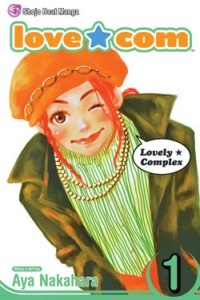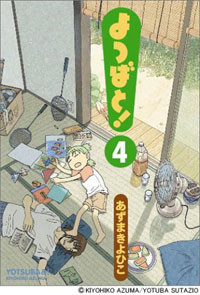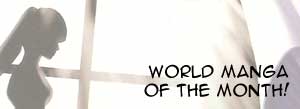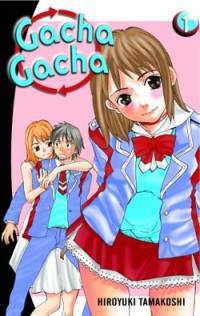RIGHT TURN ONLY!!
Yotsuba and RTO
by Carlo Santos,

Osamu Tezuka is imprisoned in an Ivory Tower. (In America.)
People love to discuss Tezuka. They love to talk about how important he is. And yet if you wanted an easily accessible path to enjoying Tezuka's works ... that'd be a bit of a stretch.
They publish books about his life, hold museum exhibits in his honor, raise him on an academic pedestal—everything except actually putting out his manga. You can have three Narutos a month, but trying to get a single volume of Phoenix is like pulling teeth. Astro Boy flickers in and out of existence on store shelves. Even an easily licensable short series like Princess Knight is relegated to "very special episode" status in one issue of one magazine. How is it that the most dependable producer of Tezuka's work (in America) is a boutique literary publisher that's targeted way above the heads of the kids who SHOULD be reading his stuff?
I don't know who decided to shut Osamu Tezuka in the Ivory Tower, but someone ought to let him out.
APOTHECARIUS ARGENTUM

Vol. 1
(by Tomomi Yamashita, CMX, $9.99)
FROM THE BACK COVER:
"As a boy, Argent was a poison tester for a royal family. He developed an unusual immunity towards toxic substances, and later he became a master chemist with the ability to cure any illness. Returning to the kingdom after a long absence, he is assigned to watch over Princess Primula once again. But any relationship that might develop between the two will have its limits; Argent's very touch has itself become poisonous!"
EVIDENCE FOR:
Who knew that chemistry—or, to be precise, pharmaceutical science—could be so cool? Argent's role as a mixmaster of medieval remedies calls to mind another fictional doctor, Black Jack, although our silver-haired hero isn't nearly as famous. The character's level of genius is definitely there, however: this series is at its most spellbinding when Argent is diagnosing, formulating, and breathlessly reciting the uses and effects of medicinal herbs and plants. His existence as a "living poison" also brings a classic moral dilemma to the story: how can he be a healer when his own body is a killing device? The volume's third chapter, where Argent goes on a diplomatic mission, highlights this personal conflict especially well. Long chapters of 40-plus pages give enough room to develop the characters—not just Argent, but also the princess and even the king. Most readers should find the variety of character designs appealing (got to love Argent's long flowing locks), and the layouts are all about getting this fascinating story across.
EVIDENCE AGAINST:
A fascinating story ... or just a fake story? Look past the medical/herbological/pharmaceutical geek party, and Argent's adventures turn out to be awfully shallow. Every time a serious opportunity for conflict arises, it's quickly deflected into an easy-out situation: "Oh, that's okay, we don't mind, now let's all hug and hold hands." What's with all these Hallmark-card endings at the end of each chapter? A tense, unresolved "to be continued" would be much more effective. The setting of the series also lacks punch; it's a stale fantasy world where someone just comes up with funny-sounding place names and tosses in a generic feudal political situation. A kingdom here, a border dispute there—the background art isn't doing much to help either, with all those traced-from-a-book medieval houses and workshops and castles. Here's a series with a really good inner core, but no sense of creativity when it comes to the outside world.
FINAL VERDICT:
A life-saving, walking-poison apothecary is a really good start! But if the fundamentals of story and setting aren't handled better, it's going to be stuck permanently at C+.
EYESHIELD 21

Vol. 14
(by Riichiro Inagaki and Yusuke Murata, Viz Media, $7.99)
FROM THE BACK COVER:
"Wimpy Sena Kobayakawa has been running away from bullies all his life. But when the football gear comes on, things change—Sena's speed and uncanny ability to elude big bullies just might give him what it takes to become a great high school football hero! Catch all the bone-crushing action and slapstick comedy of Japan's hottest football manga!
The Devil Bats' game against the Poseidons has begun! Besides a huge size advantage, the Poseidons boast the 'High Wave,' a powerful attack that threatens to wpie out all opposition. Mid-game, the Devil Bats' quarterback decides that it's time to unveil a new counterattack, but will it be enough to stop the team's slide into defeat?!"
EVIDENCE FOR:
Yeah! The awesome side of Eyeshield 21 is back! This is the kind of action that was sorely missed in the previous volume—nonstop football from cover to cover. Every page explodes with intense action scenes and flawless artwork, detailing each snap, spin, turn, pass, block, and tackle of the Deimon-Kyoshin game. Even the Poseidons' cheesy aquatic metaphors (the "High Wave" defense? the "swim" maneuver?) bring a grandiose majesty to the artwork; go ahead and add ocean waves and water spray to Murata's list of drawing skills. This point of the series is also, perhaps, Deimon's first true test of their abilities as a complete team: Hiruma, Eyeshield and Monta's multi-pronged offense, Komusubi and the Hah Brothers lighting it up at the front line, even pirouetting nutcase Taki getting his moment in the spotlight. Throw in some trick-play strategies and this is the kind of American football you only wish they had in real life. It's an absolute joy to see art and sport collide like this, with action, drama and humor (see the in-between chapter pages for hilarious trivia tidbits) all working together to achieve the win.
EVIDENCE AGAINST:
You know how people get on the case of various well-known fighting series when the battles drag on too long? The same complaint might be made of this volume, which is basically one long game, with the final play even carrying over into the next installment. Get ready to settle in for the long haul (and bring a beer hat with you). And not only is it a long game, but also a complex one, with maybe a dozen key players between the two teams—anyone who's not a serious Eyeshield enthusiast might have to backtrack and try to remember who's who. Adding to the confusion is the pointless sideline commentary from Ojo High School's team, who are there just to spectate. It's like that one annoying commentator on every broadcast team who makes fluff remarks like: "Look at that great play! Smart move by Eyeshield!" Well, of course it was a great play, he gained 10 yards. Thanks, Captain Obvious.
FINAL VERDICT:
What kind of weirdo complains about football games being too long? Let this volume show that Eyeshield 21 is, indeed, one of the greatest sports manga right now. Instant A.
GIN TAMA

Vol. 1
(by Hideaki Sorachi, Viz Media, $7.99)
FROM THE BACK COVER:
"The samurai didn't stand a chance. First, the aliens invaded Japan. Next, they took all the jobs. And then they confiscated everyone's swords. So what does a hotheaded former samurai like Sakata 'Gin' Gintoki do to make ends meet? Take any odd job that comes his way, even if it means losing his dignity...
Sleazy alien moneylenders, monsters on the rampage, and a ticking time bomb may all be in a day's work for Gin, but a drop in his blood sugar level means trouble for everyone!"
EVIDENCE FOR:
If there's any series that epitomizes the spirit of Shonen Jump, it's this one: boundless energy from page to page, with wild adventure scenes that awaken the kid in all of us. The concept itself is ridiculous yet addictive—imagine Edo-period Japan infused with all the conveniences of the 21st century and beyond, thanks to a futuristic alien invasion. While this might make some folks' brains snap in two, it also opens the door to countless possibilities, like Gin hijacking a flying car so he can save a girl from being sold to an airborne brothel. Yes, it's as crazy as it sounds, and looks even crazier on the page. But this wild romp with swords and fast vehicles and lots and lots of speedlines has some other dimensions to it: the unease between aliens and humans sparks some social commentary about "invaders" and a conflict of "national identity" (paging Taro Aso); it's also hard to miss the biting sense of humor that Gin brings to the series. His smart-mouthed cynicism is a far cry from the classic purehearted SJ hero, and that's what makes him so fascinating. Gin's pals are fascinating as well, with a wide range of memorable character designs that emphasize this whole wacky Edo-period melting pot.
EVIDENCE AGAINST:
This series is completely unfair to people whose brains do snap in two at the mere thought of a time period crossover. The first chapter mercilessly throws the reader into the deep end, and if you haven't bought into the whole "Edo Meets Modern" concept, it's an incredibly disorienting experience. Plus those cat-headed aliens are just plain freaky. ALL creatures with humanoid bodies and animal heads are freaky. And it's not like things get more organized later on—there's no continuity been chapters, resulting in an "odd jobs Gin" effect where nobody knows what he'll be doing next. Although new characters are added to the cast along the way, the storyline itself has no driving force: What does Gin want out of life? What is he working towards? Essential elements like that are completely glossed over. Even the artwork lacks a solid core, relying on a generic Shonen Jump house style rather than reflecting the artist's personality. Will the real Hideaki Sorachi please show up?
FINAL VERDICT:
The bizarre, disorganized story gets a free pass because it's just so much fun to read. That's a respectable B right there.
LOVE*COM

Vol. 1
(by Aya Nakahara, Viz Media, $8.99)
FROM THE BACK COVER:
"Risa Koizumi is the tallest girl in her class, and the last thing she wants is the humiliation of standing next to Atsushi Ôtani, the shortest guy. Fate and the whole school have other ideas, and the two find themselves cast as the unwilling stars of a bizarre romantic comedy.
Rather than bow to the inevitable, Risa and Atsushi join forces to pursue their true objects of affection. But will their budding friendship become something more complex?"
EVIDENCE FOR:
Love*Com could very well be a candidate for best sarcastic dialogue ... ever. This is one of those few comics you actually want to read out loud, because when Ôtani and Koizumi start going at it, it's a veritable goldmine of height jokes and snappy comebacks. For those who prefer a little more substance, there's also the overarching plotline where Ms. Gigantic and Mr. Tiny are totally destined for each other, except neither of them wants to admit it, leading to a romantic tug-of-war that's a delight to follow. Will they? Won't they? Clean linework and character designs are a big plus on the artistic side—yes, it's still very much a mainstream shoujo work, but one where you can actually tell people apart, and they're not all buried under thirty layers of tones and sparkles. Keep an eye on the varied facial expressions, too, because that's where a lot of the humor and sarcasm comes out. One look at these kids' faces and you'll understand the true pain of being an oversized girl, or in Ôtani's case, an undersized guy, which is one thing I sympathize with only too well.
EVIDENCE AGAINST:
The trouble with having a clean, simple style is that, in the hands of a less-than-perfect artist, it just ends up looking plain. That's the problem that plagues these early chapters, which leave too much white on the page (a little more tone wouldn't hurt, honestly) and rely too much on the front-facing talking head pose (there are other, more creative ways to stage a conversation). Then there's the issue of the characters themselves—for this moto perpetuo of love to work, they have to be selectively stupid, which leads to a lot of head-slapping situations that could easily be solved if they just used their brains and were honest with each other. But if that happened, it wouldn't be a bouncy love comedy anymore, would it? Even the stellar dialogue has its problems at times; the rapid back-and-forth pace gets derailed and you lose track of who's talking. When both characters are uniformly angry, and sarcastic, and facing the same problems in love, it's only natural to get confused from time to time.
FINAL VERDICT:
Okay, so this first volume is still trying to work out the kinks, but the dialogue is so much fun, and the characters so colorful, that it deserves a good solid B.
YOTSUBA&!

Vol. 4
(by Kiyohiko Azuma, ADV Manga, $9.99)
FROM THE BACK COVER:
"Having already tackled such diverse topics as cicadas and global warming, Yotusba is back and ready to face a whole new set of challenges. SEE as she strives to master the complexities of rock-paper-scissors! FEEL as she becomes one with the water during a weekend of fishing. BE CONFUSED as she tries to get money from strangers to buy her groceries!"
EVIDENCE FOR:
Has Yotsuba&! ever been anything less than brilliant? This is another wonderful and weird trip through the mind of everyone's favorite 6-year-old kid, and it just keeps getting better from chapter to chapter. Volume 4 perfectly captures the lilting rhythm of the summer holidays; you can almost feel the heat and the lazy days as Yotsuba gets into her usual scrapes around the house and the neighborhood. The second half of the book is observational humor at its absolute pinnacle: Yotsuba tries to solve Fuka's early-teen heartbreak in ways only a little child can, and then she tries to start her own handmade "newspaper"—with scandalous results!—and reckons that the best way to solve global warming is to turn on every air-conditioner in the house. It's a nonstop string of laughs from one scene to the next, carried by Azuma's effortless layouts and clean yet expressive style. Clearly, early-childhood researchers no longer need to perform psychological tests on kindergarteners—they just need to talk to Kiyohiko Azuma, who can see into the mind of a child better than anyone else ... and come up with hilarious results.
EVIDENCE AGAINST:
Come to think of it, there are plenty of times when Yotsuba&! is less than brilliant—usually when the series defeats itself by dragging out a joke too long. Take the fishing chapter, for example, which keeps harping on the same gag over and over: Miura is easily grossed out by things. Okay, we get it. The first time, the second time, and the third time ... The grocery shopping chapter is even less interesting, as it never finds a comedic groove (apart from Yotsuba's commentary on quail eggs), so we basically get stuck with watching a dad and daughter shop for tonight's dinner ingredients. As one might imagine, this is not exactly high on the humor scale. There are moments of artistic laziness as well, mostly in the backgrounds, which rely too much on photo references—and it's really easy to tell. It's understandable that a manga-ka has to take some shortcuts to get the work turned in on time, but seeing someone with this level of talent come so close to "cheating" is kind of a disappointment.
FINAL VERDICT:
Who would dare judge against Yotsuba&! when it makes one feel so happy and fluffy inside? Please, enjoy this slice of childhood that earns a very respectable A-.

RHYSMYTH

Vol. 1
(by Anthony Andora and Lincy Chan, Tokyopop, $9.99)
FROM THE BACK COVER:
"Welcome to America's newest and most popular sport: Rhysmyth! Featuring one-on-one dance battles atop a hi-tech glass court grid, when the music hits, you and your opponent dance across a digital minefield for the glory of being the most stylish Rhysmyther!
High school student Elena is looking for a little something extra to beef up her college applications. When she is thrust into the fast-paced world of Rhysmyth, she begins to get her groove on. But is Elena truly ready for the rivalry...and romance?!"
EVIDENCE FOR:
Truth: it is impossible to play a round of Dance Dance Revolution (or In the Groove, or Pump It Up, or Stepmania if you're a cheapskate) without looking completely ridiculous. I still close my apartment curtains whenever I pull out the dance pad for a little arrow-bopping. But Rhysmyth, which elevates the dance-game concept to a freeform, 56-square challenge that rewards improvisation as much as synchronization, sounds and looks awesome. It's always tricky coming up with a solid set of rules for a made-up "sport" (think Quidditch), but this one pulls it off. While the first volume starts out like a typical sports underdog story, it quickly blossoms into something not often seen—a girls' underdog story, where self-confidence and romantic intrigue take center stage, and the raw urge to get stronger is less important. This is most evident in the chapter where Elena runs into the team captain and his dog while out jogging—it's just a sweet, character-and-relationship-building moment that shows where the series' true heart lies. It's not so much about mastering a futuristic dancing video game, but about making good friends and making yourself a better person.
EVIDENCE AGAINST:
When art teachers warn you about using the elements of a style without understanding the fundamentals, they will point to this. Oh sure, there's the shiny anime eyes, and cute girls with swishy hair, and buff, brooding guys, but off-kilter facial proportions and awkward poses make this visually painful to read. Rhysmyth, as a game, probably is awesome to watch—but the artwork doesn't make it seem so, as the characters tend to just float and contort over the electronic grid. It's depressing that such a dynamic concept is being presented with zero dynamic qualities on the page. (And to think, it was almost a rap contest instead—yikes!) The high school setting does little to help the story, either, as it waddles through every cliché of popular American youth entertainment: the cool attractive guy of ambiguous racial background, the predictably bookish best friend, the rich bitch with a surname for a first name. And of course, when the time of reckoning comes, Elena miraculously goes from total suck to total win by the power of her heart. Goodness, this series needs ponies or something. We implore Tokyopop's artists and their editors to expand their cultural boundaries and start stealing from sources other than the Sweet Valley books and Disney channel.
FINAL VERDICT:
If this segment were graded, Rhysmyth would receive an Incomplete—the ambition is there, but the talent hasn't shown up yet. Can the series' creators level up quickly enough to deliver a stronger 2nd volume?

From the absolute heights of comedy last week, we now bring you to one of its absolute lows! The only laughs this time will be ones of disbelief at the Worst Manga I've Ever Read:
GACHA GACHA / GACHA GACHA: THE NEXT REVOLUTION

(by Hiroyuki Tamakoshi , Del Rey, $10.95/$12.95 ea.)
I'm not sure why I keep following up with the occasional volume of Gacha Gacha. Maybe it's because, as a heterosexual male, I like boobs.
Unfortunately, I also hate really dumb stories that go nowhere.
Whether it's the original series (5 volumes) or the second arc (re-titled "The Next Revolution" in the US and published differently due to mature content), the elements are the same: a hapless schoolboy, a freak video-gaming accident, and a resulting plurality of hot girls interacting with said schoolboy. How people are able to enjoy this without suffering major cerebral damage is a mystery to me. Somehow, perfectly ordinary scenarios with romantic potential, like hanging out at school or going out to eat, always lead to improbable feats of ecchi where our young hero gets a faceful of boobs or a strategic panty peek. Sometimes (okay, often times) the girls even strip voluntarily! What kind of world is this, and when can I move in?
As you can see, what qualifies Gacha Gacha for epic badness is its monumental stupidity. There is only one way to improve the series, and that is by erasing all dialogue, removing any scenes that further the characters or plot, and pasting together the remaining illustrations of exposed female anatomy, because that's the only good thing left. But hell, for $11 or $13 a pop I could just grab a couple of issues of Maxim or a copy of UpToBoy and get the same effect. And I'd probably save on brain cells that way.
discuss this in the forum (45 posts) |